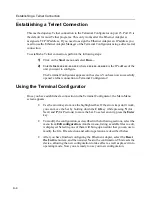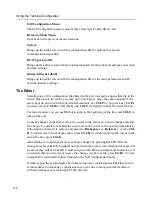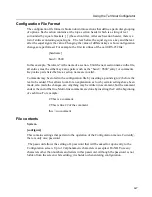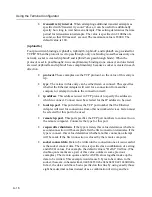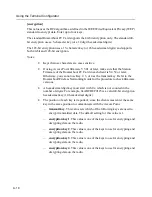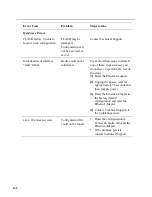
A-15
Using the Terminal Configurator
Network Bindings
This section describes the meaning behind each of the entries that describe network
binding.
[rmpbind]
This binding can be used for both the passthrough protocol and for the I/O control socket
setting.
•
protocol. This example uses the RMP protocol so the value of this entry is
“rmp.” RMP binding options are described below. If you wish to use the
TCP/IP protocol, skip to the next example.
•
source address. This is the value that the Ethernet Adapter will use to
identify its serial port when sending serial data to and receiving serial data
from other Ethernet Adapter units. In short, this is its port address. The default
value is “default” which will cause the Ethernet Adapter to use its serial
number as the address.
•
source address filter. Setting this value will tell the Ethernet Adapter to only
accept data coming from the address specified. For example, if this entry is
set to “1234,” only data originating from a Ethernet Adapter with the port
address of “1234” will be accepted. All other data will be ignored that does
not have the source address filter set to a specific address. The default value
is “none.”
•
destination address. This address tells the Ethernet Adapter which port
address to send data received from the serial port. It can be the port address
of another Ethernet Adapter’s serial port, or it can be “broadcast” or
“dynamic.” Broadcast means to send the data to all of the Ethernet Adapter
devices. Dynamic means sending the data to the Ethernet Adapter from which
it last received data. Dynamic has the effect of causing two Ethernet Adapter
units that are by themselves to communicate to each other. The default value
is “dynamic.”
•
transmit try count. For non-broadcast data, this count specifies the number
of attempts that the Ethernet Adapter should make in transmitting each piece
of data to a remote Ethernet Adapter. A transmission may fail if the
destination Ethernet Adapter is out of range or turned off. When this happens,
the data will be lost if additional attempts are not made. This count gives the
user the ability to tell the Ethernet Adapter how diligently to attempt
transmission of data. The maximum count is 65,000 times. The default value
is infinite.




